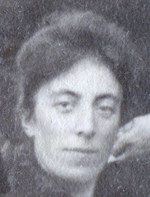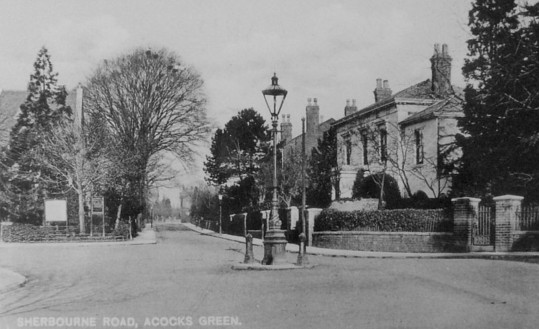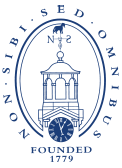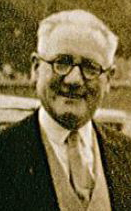.jpg)
Date of birth: Sunday, 9th April, 1843.
Birthplace: Manchester, Lancashire, England.
Date of death: Sunday, 2nd May, 1909 (aged 66 years).
Place of death: Rosedale, Sherbourne Road, Acocks Green, Birmingham, England.
Buried: Buried in Yardley Cemetery, grave no 8898, section 23, second row, nine from top (walking from island).
Signature:

_Portrait.jpg)

Eleanor "Nellie" Amelia Enock (nee Wilson) (1858-1932). |
Date of marriage: Saturday, 26th November, 1892.
Place of marriage: Register Office, Solihull, Birmingham.
April-September 1845 - 59, Stocks Street, Cheetham, Manchester, England.
House demolished in between 1958-1962. House stood where the Rothwell & Thomas is now located.
1847 - 17, Bath Row, Lee Bank, Birmingham, England.
Number 17 was located near to the Birmingham Canal.
1850-1853 - Stratford Road, Sparkbrook, Birmingham, England.
According to the 1851 census, the Enocks were seven entries away from the Angel Inn Hotel. By tying this information in with the 1889 OS town plan of Birmingham, the Enocks would have lived next-door to Ladypool School. The house was demolished to make way for St. Agatha's Church around 1898.
1853 - Balsall Heath Road, Balsall Heath, Birmingham, England.
1855 - 399, Bristol Road "Sussex Place", Edgbaston, Birmingham, England.
Demolished between 1956-1966.
1862-1864 - 75 Ryland Road (Gothic Cottage/Gothic Lodge), Edgbaston, Birmingham, England.
1871-1874 - 25 Balsall Heath Road, Balsall Heath, Birmingham, England.
Annual rent: 1874: £20 10s. (£9k in 2016), or £1. 5s. 7d. a month (£750 in 2016).
Occupants (1871 census): Robinson Enock, Edwin Enock, Sophia Elizabeth Enock.
1879 - Westwood House, Avenue Road (The Avenue), Acocks Green, Birmingham, England.
Robinson and his sister, Sophia, were lodging with the Maddocks family.
1881-1896 - Brooklyn Villa (now number 29), The Avenue, Acocks Green, Birmingham.
Occupants (1891 census): Robinson Enock, Eleanor Amelia Wilson.
Brooklyn Villa (house with the red door) pictured in August 2014 (click to enlarge).
1893-1909 - Rosedale, Sherbourne Road, Acocks Green, Birmingham, England.
"Sherbourne was at one time one of the most exclusive roads in Acocks Green."
Annual rent: 1906: £27 (£9k in 2016), or £2. 10s. 2d. a month (£750 in 2016).
Occupants (1901 census): Robinson Enock, Eleanor Amelia Enock, Amy Clara Elizabeth Enock, Robert Doeg Enock, Gertrude Margaret Enock, Laura Hopwood Enock (sister-in-law), Maud Muriel Enock (niece).
Servants (1901 census): Nellie Birch.
Rosedale was demolished and replaced by flats in the 1960s.


Photos of Sherbourne Road dating from the early 1900s. Rosedale can be seen between the lamppost and the white building in the top photo, and the front gate can be seen on the far right of the bottom photo.
Aerial view of Acocks Green c1950. Rosedale has been highlighted red.
Sherbourne Road, pictured in August 2014. Rosedale was replaced by flats in the 1960s (click to enlarge).
Rosedale was replaced by flats in the 1960's (click to enlarge).

Admit number: 7497.
Agent: William Southall.
Relatives in attendance: Frederick
Enock (brother), Emma Enock
(sister) and Edwin Enock (brother).
'Those who were at school with Robinson Enock will remember him as one of those most active and energetic in all games, Smugglers, Prisoners' Base, "Relieve Oh", and in the last named few could stand against, "Chargers" (his nickname) charging to relieve prisoners. Others will remember him as the happy Lodge-keeper [see below], ever on the alert to rush out into the village at the cry of "Kite's gone, Kite's gone!" and many a sharp tussle he had when the "villaggers" had "slung" a kite. Like most of his school-mates, he was not particularly brilliant in any one branch of study, with one exception, viz., that he was "rare cop" at mental calculation, a faculty which he soon turned to account on entering the service of the Birmingham Railway Co. in 1859' Ackworth memorial notice.
Lodge Keeper.
'The most coveted office of all came to be that of "lodge keeper", not for the rewards it brought but the privileges in earned. This was a permanent post; the two lodge-keepers shared the responsibility for ringing the school bell, lighting the fires in the office and the lodge, and running errands for the Superintendent, either on the school premises or further a field, even as far as Pontefract.' - Ackworth School - Elfrida Vipont.
Life at Ackworth.
Between the ages of eleven and fifteen, Robinson was away from family life for eleven-months of the year, only returning home during the one-month annual summer holiday.
Robinson, Fred, Emma and Edwin, would have only seen one another at meeting for worship or other public occasions. To spend time together, the siblings would have congregated on a path running midway between the two wings known as "The Flags".
Scholars studied during the day, and undertook some manual work out-of-hours.
The curriculum between 1854-1858 consisted of:
Manual work included:
A letter from Robinson to his mother dated 1856.
Staff at Ackworth School during Robinson's schooling:
Superintendent: Thomas Pumphrey.
Masters: Thomas Brown, John Newby (Master of Grammar and Latin), Henry
Thompson, William Pollard, Henry Sparkes (Master of Drawing), John Frederick
Harris, John William Watson, William Tallack, Francis William Wood, George
Frederick Linney, Thomas Frederick Ball.
Master on Duty (outdoor inspection of boys during play-hours): Henry
Wilson, Thomas Puplett.
Visiting Reading Master: Thomas King Greenbank (three-weeks in 1856).
Visiting Drawing Master: John C. Swallow, John White, Charles Ryan.
Housekeeper: Sarah Maddocks.
Boys' Matron: Sophia Gregory.
Nurse: Mary Williamson.
Principal Tailor: George Frederick Linney.
Principal Shoemaker: Isaac Levitt.
Baker: John Walker.
Husbandman (Farmer): William Cammage.
Principal Gardener: James Jones.
Additional information on Ackworth School can be found here.
1859-c1860 - Birmingham Railway Co.
Clerk
c1860-1908 - Lloyd and Lloyd (Stewarts and Lloyds from 1903), Albion Tube Works, Nile Street, Birmingham, England
Commercial Clerk/Book Keeper
”He shortly afterwards went to Messrs. Lloyd and Lloyd, of the Albion Tube Works, then just established, being at first their one and only clerk. Here he worked early and late, seeing the business and the premises enlarged by leaps and bounds, until the staff became a great company…...Between twenty and thirty years ago R.E.’s hearing began to be seriously affected, becoming worse and worse, until absolute deafness compelled him to give up much of his socialbility; but in spite of this great affliction he continued to carry on and organise plans for the work of the firm, which had now assumed such vast proportions, that it was known all over the world. Here he remained until his health broke down, and in spite of the unceasing kindness and consideration of John Henry Lloyd, he was, after forty-nine years of faithful service, obliged to succumb, for he was now struck down with that fell disease cancer….” – Ackworth Old Scholars Association Memorial Notice
Background
The firm of Lloyd and Lloyd was founded in the year of 1859 by Mr. Samuel Lloyd and Mr. Edward Rigge Lloyd. Boiler tube furnaces were erected at the Albion Tube Works on Nile Street, Birmingham. The business developed rapidly and plant for the manufacture of screwed coupled tubes and fittings was soon added on the opposite side of Nile Street, where larger offices were also erected.
In 1870, Lloyd and Lloyd amalgamated with Henry Howard & Co., a manufacturer of wrought iron screwed and coupled tubes and fittings, which operated the Coombs Wood Works in Halesowen. Over the next 30 years continuous extension and development took place at Coombs Wood Works, new processes were added for the manufacture of both butt and lapwelded iron and steel tubes and accessories, and a large modern plant with all the latest improvements for the manufacture of spelter.
Lloyd and Lloyd always endeavoured to secure the highest possible standard in all their manufactures with the result that the brand ‘L & L’ became universally known as a guarantee of quality.
The company’s attitude to its workforce was sympathetic and resulted in the establishment of excellent relations between employers and employed. Many schemes were adopted for their benefit, including numbers of houses built and schools provided.
After several years of research and development, the company became the first manufacturers of large gas welded tubes and flues, and in 1892 secured the European rights under the Bernardos process of electric welding.
In 1900, Lloyd and Lloyd, now a private limited company, decided to manufacture seamless tubes in the Glasgow district and accordingly purchased the Clyneside Tube Works Co. Ltd, at Whifflet, which comprised one boiler tube furnace making tubes up to 11 inches in diameter, and one gas tube furnace with fitting and socket makers’ hearths and 21 acres of land available for extension.
At the turn of the century, A. & J. Stewart and Menzies Limited were well established in all branches of the trade and were the largest tube-making concern in Scotland. Because of the limitations of the market in Scotland a considerable export trade had been built up over the years, particularly for gas and water mains. In England, Lloyd and Lloyd occupied a similar premier position in the industry, their speciality being screwed and socketed tubes.
By 1903 the two firms were beginning to be acutely conscious of each other’s presence, but instead of entering into competition they took stock of their relative positions and found that their interests were complementary, which resulted in their amalgamation in 1903 and produce Stewarts and Lloyds.
The location of Albion Tube Works today.
In the late 1870s/early 1880s, Robinson's hearing became impaired. The problem gradually grew worse eventually leading to total deafness. Due to the disability, Robinson had to give up much sociability; however, he continued to carry on, and organise plans for Lloyd and Lloyd.
Deafness appears to be a common trait in the family; Sophia Derrington (Robinson's sister), Madge (Robinson's daughter) and Ernie Wildridge (Robinson's grandson) all experienced hearing issues.
Robinson, spent much of leisure time in loving attendance on his flower garden, each year sowing and planting the favourites of his beloved mother.' - Ackworth memorial notice.
Writing
It seems as though Robinson had an interest in writing. Click on the image below to read a short story written by him in July, 1879.
Cricket
Played for the Gwyther Lodge Cricket Club of Yardley between 1886 and 1897 along with his brother-in-law Edwin Derrington. He was Vice-President of the club in 1889.
Natural History
Societies
Robinson was a subscriber to the Neglected Children's Aid Society of Birmingham.
The object of the society was to look after the neglected children of the streets, with a view to accomplishing the following results:
1. To place such as may be proper objects in certified industrial or other schools.
2. To restore such as may be lost to their parents.
3. To report any cases not coming within the foregoing heads to such institutions or persons as may have the means of rendering aid.
4. To render assistance to the Magistrates, if required, in enforcing payments of contributions by parents of children in certified industrial schools, towards the expenses of such children.
5. To assist the manager of certified industrial schools in finding employment for pupils wanting it.
6. To visit children placed out to service after leaving certified industrial schools.
7. To make enquireies into cases of destitute children sent to the visitor by subscribers.
Robinson Enock.
Gross value of estate: £829 3s. 6d (worth £82k in 2017).
Net value of Personal Estate: £786 13s. 3d. (worth £78k in 2017).
Executors: Eleanor
Amelia Enock (wife) and Edwin
George Derrington (brother-in-law).
"I give and bequeath unto my wife Eleanor Amelia Enock, all my property and money of whatsoever description, that I may die possessed of, to her absolutely." - Robinson Enock.
Witnesses: Maud Muriel Enock, Emily Yapp Powell.
Eleanor Enock.
14th July 1933.
Gross value of estate: £807 12s. 11d. (worth £54.5k in 2017).
Net value of Personal estate: £790 3s. 4d. (worth £53.3k in
2017).
Executors: Robert Doeg Enock
(34 Dudley Park Road, Acocks Green) and Max William Jacobi (12 Dudley Park
Road, Acocks Green).

Max Jacobi.
'I give and bequeath to my eldest daughter Amy Clara Elizabeth Enock my piano in rosewood case by "Mercur"Berlin". I give to my youngest daughter Gertrude Margaret Enock the whole of the contents of 45 Homecroft Road Yardley with the exception of the piano mentioned above. The residue of my estate if any after the foregoing bequests have been satisfied I give and bequeath in the following manner: to my grandchildren Muriel Joyce Enock and Clive Robin Enock the sun of £50 each, any residue then remaining to be divided equally between my daughters Amy Clara Elizabeth Enock and Gertrude Margaret Enock share and share alike.'
Witnesses: Agnes Anne Blizard (Manuel Cottage, Stow-on-the-Wold) and Florence Briggs (Tufa Mount, Willard Road, Yardley, Birmingham.
6th August 1932.
'I wish to revoke the legacies in the foregoing Will to my grandchildren Muriel Joyce Enock and Clive Robin Enock and for the sum previously bequeathed to them totalling £100 to go into the residue of my estate and to be dealth with accordingly.'
Witnesses: Edwin George Derrington (brother-in-law) and Florence Briggs, both of Tufa Mount, Yardley).
Page updated 12th January, 2025.